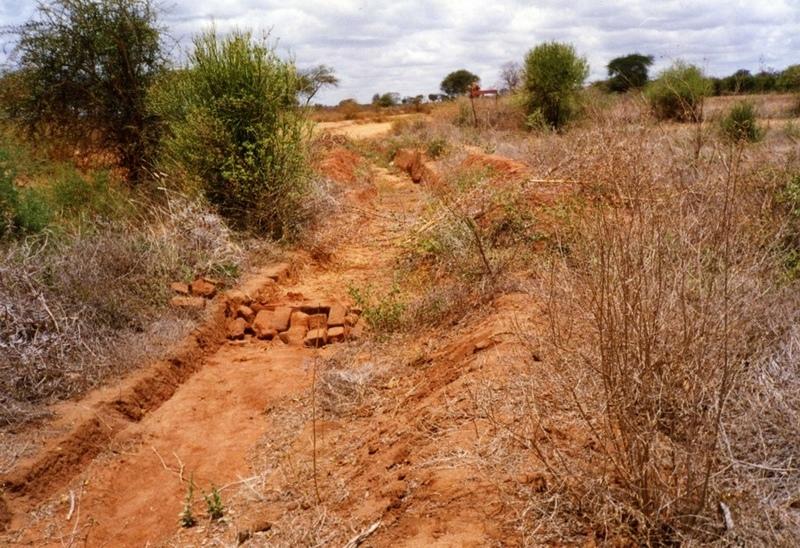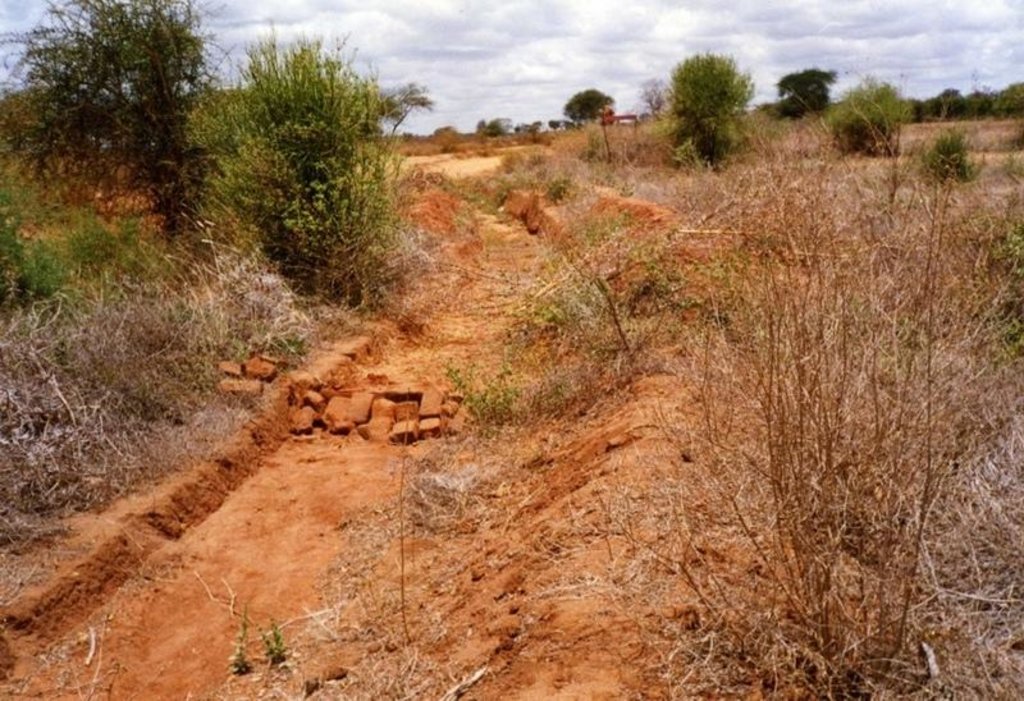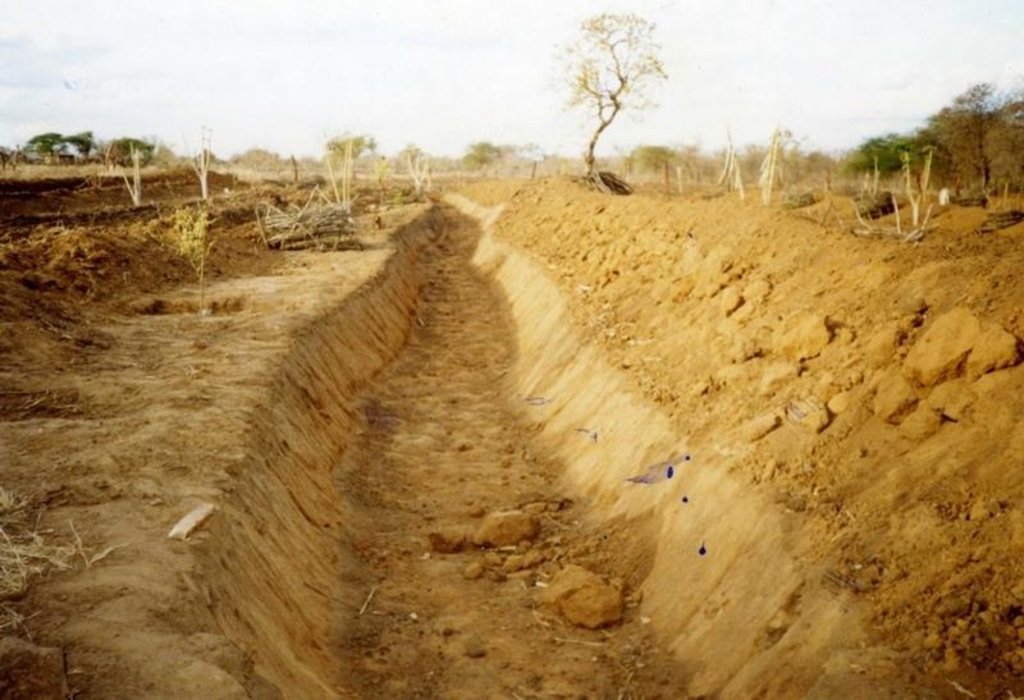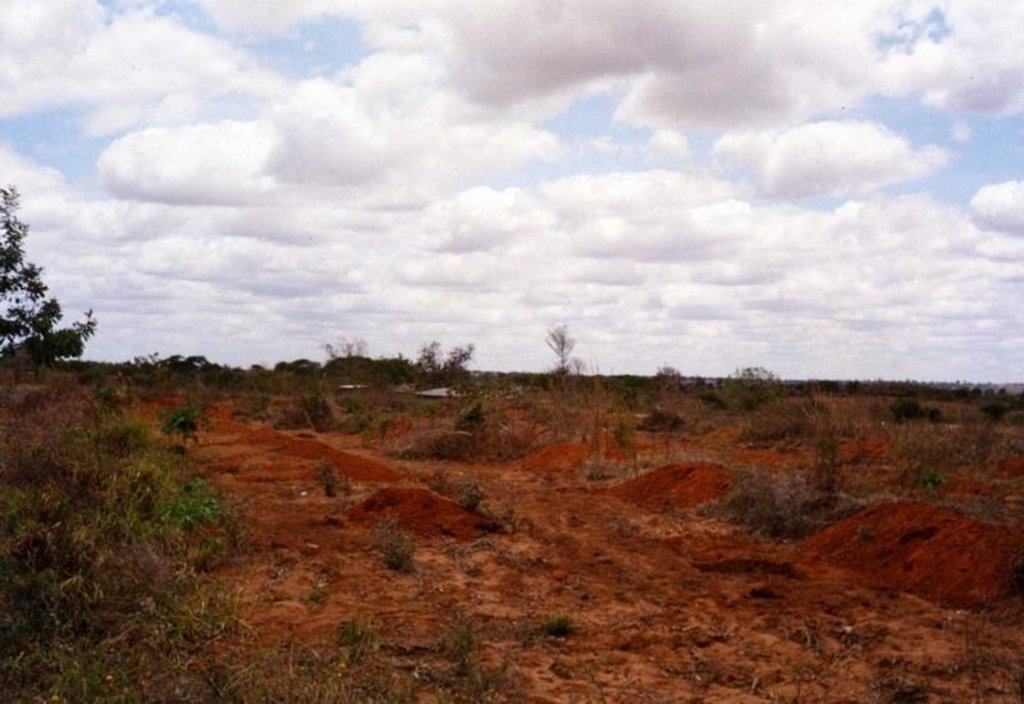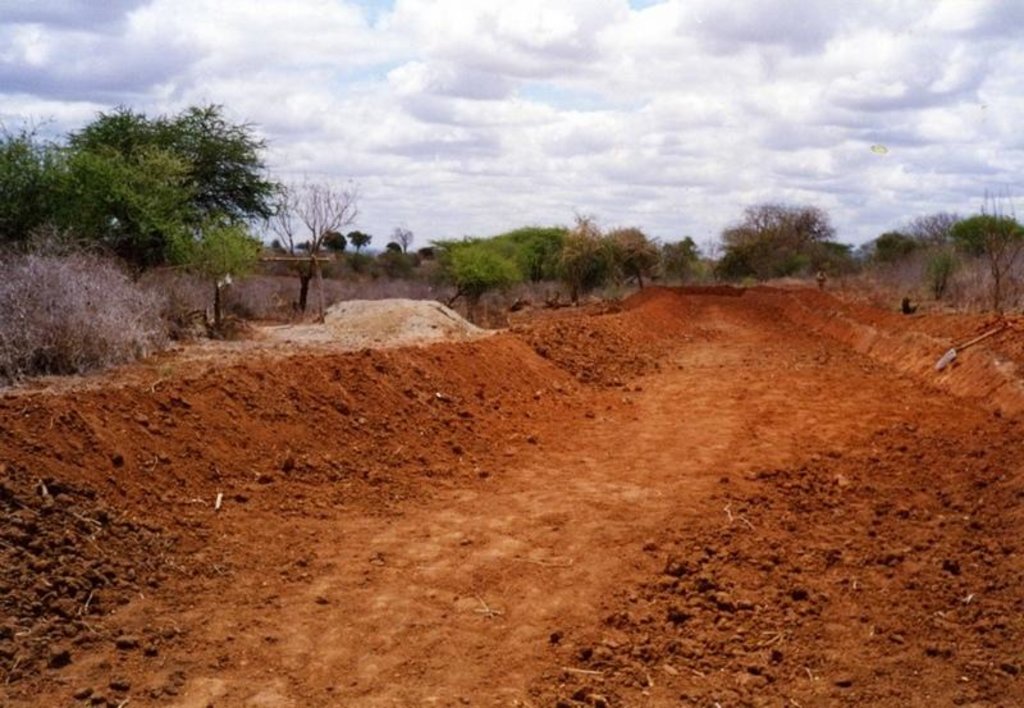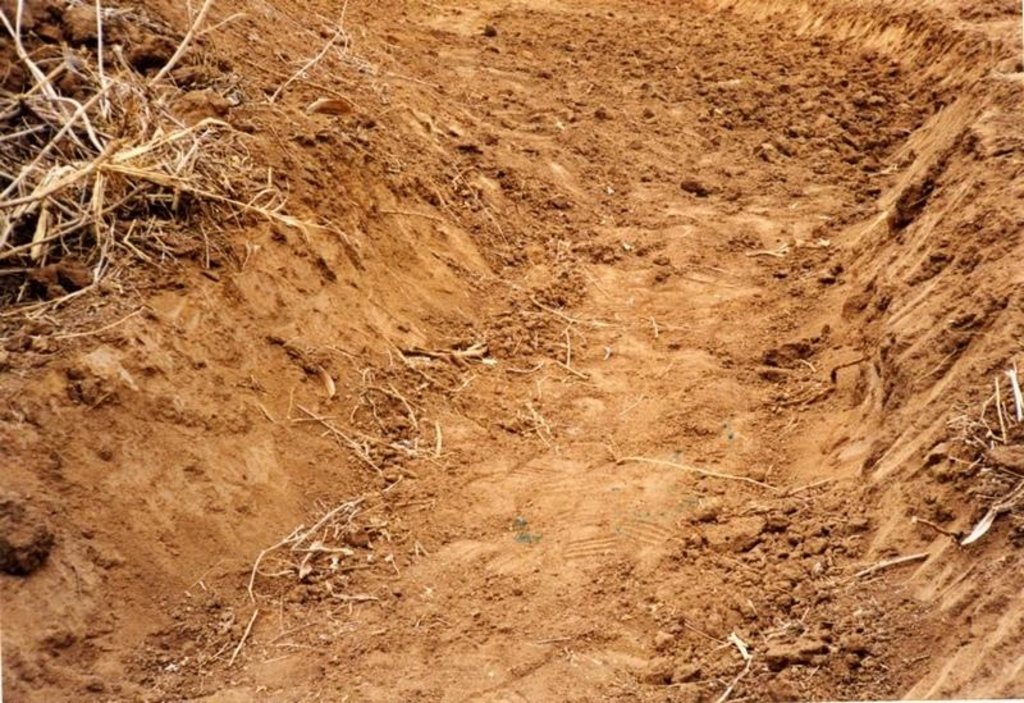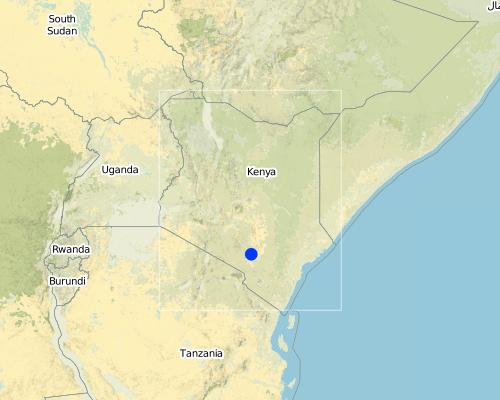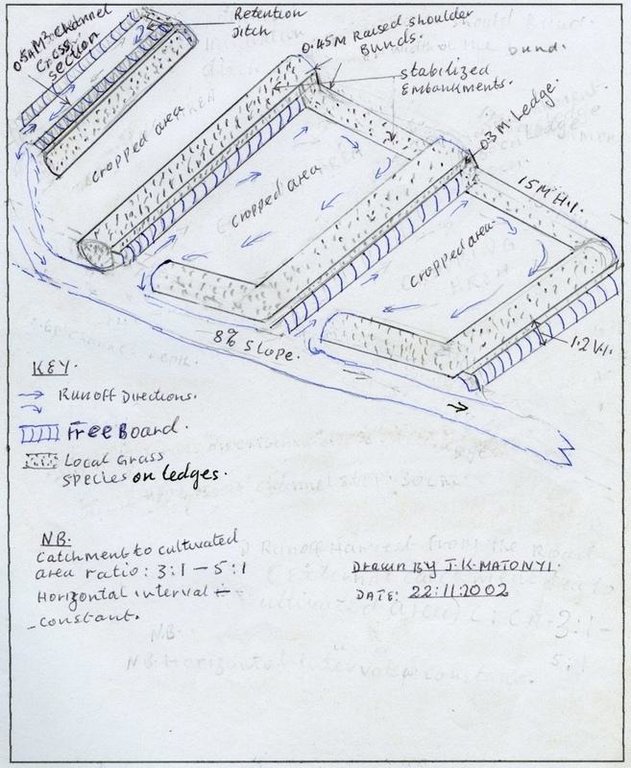Water harvest [ເຄັນຢາ]
- ການສ້າງ:
- ປັບປູງ:
- ຜູ້ສັງລວມຂໍ້ມູນ: Kithinji Mutunga
- ບັນນາທິການ: –
- ຜູ້ທົບທວນຄືນ: David Streiff
Kunasa maji ya muua yanuyobubugika na kuyuelekeza shambani kwa uzakshaji-Alex R.Adual RSCU/SIDA1996
technologies_1097 - ເຄັນຢາ
ເບິ່ງພາກສ່ວນ
ຂະຫຍາຍທັງໝົດ ຍຸບທັງໝົດ1. ຂໍ້ມູນທົ່ວໄປ
1.2 ຂໍ້ມູນ ການຕິດຕໍ່ພົວພັນ ຂອງບຸກຄົນທີ່ສໍາຄັນ ແລະ ສະຖາບັນ ທີ່ມີສ່ວນຮ່ວມ ໃນການປະເມີນເອກກະສານ ເຕັກໂນໂລຢີ
ບັນດາຜູ້ຕອບແບບສອບຖາມທີ່ສໍາຄັນ ()
ຜຸ້ຊ່ຽວຊານ ດ້ານການຄຸ້ມຄອງ ທີ່ດິນແບບຍືນຍົງ:
Mutisya Peter Maithya
Daleo's office P.O.Box 42 Makueni Kenya
ເຄັນຢາ
ຜຸ້ຊ່ຽວຊານ ດ້ານການຄຸ້ມຄອງ ທີ່ດິນແບບຍືນຍົງ:
Ndengele Michael
Daleo's office P.O.Box 42 Makueni Kenya
ເຄັນຢາ
ຜຸ້ຊ່ຽວຊານ ດ້ານການຄຸ້ມຄອງ ທີ່ດິນແບບຍືນຍົງ:
Nguluu Lucas Makau
Daleo's office P.O.Box 42 Makueni Kenya
ເຄັນຢາ
ຜຸ້ຊ່ຽວຊານ ດ້ານການຄຸ້ມຄອງ ທີ່ດິນແບບຍືນຍົງ:
ຜຸ້ຊ່ຽວຊານ ດ້ານການຄຸ້ມຄອງ ທີ່ດິນແບບຍືນຍົງ:
ຜຸ້ຊ່ຽວຊານ ດ້ານການຄຸ້ມຄອງ ທີ່ດິນແບບຍືນຍົງ:
Adunal Alex R.
RELMA/SIDA
Lcraf house P.O.Box 63403 Nairobi, Kenya
ຊື່ສະຖາບັນ (ຫຼາຍສະຖາບັນ) ທີ່ອໍານວຍຄວາມສະດວກ ໃນການສ້າງເອກກະສານ / ປະເມີນ ເຕັກໂນໂລຢີ (ຖ້າກ່ຽວຂ້ອງ)
Ministry of Agriculture, Livestock and Fisheries (MoA) - ເຄັນຢາ1.3 ເງື່ອນໄຂ ກ່ຽວກັບ ການນໍາໃຊ້ຂໍ້ມູນເອກະສານ ທີ່ສ້າງຂື້ນ ໂດຍຜ່ານ ອົງການພາບລວມຂອງໂລກ ທາງດ້ານແນວທາງ ແລະ ເຕັກໂນໂລຢີ ຂອງການອານຸລັກ ທໍາມະຊາດ (WOCAT)
ເມື່ອໃດທີ່ໄດ້ສັງລວມຂໍ້ມູນ (ຢູ່ພາກສະໜາມ)?
21/04/2003
ຜູ້ປ້ອນຂໍ້ມູນ ແລະ ບຸກຄົນສຳຄັນ ທີ່ໃຫ້ຂໍ້ມູນ (ຫຼາຍ) ຍິນຍອມ ຕາມເງື່ອນໄຂ ໃນການນຳໃຊ້ຂໍ້ມູນ ເພື່ອສ້າງເປັນເອກກະສານຂອງ WOCAT:
ແມ່ນ
2. ການອະທິບາຍ ເຕັກໂນໂລຢີ ຂອງການຄຸ້ມຄອງ ທີ່ດິນແບບຍືນຍົງ
2.1 ຄໍາອະທິບາຍສັ້ນຂອງ ເຕັກໂນໂລຢີ
ການກຳໜົດຄວາມໝາຍ ຂອງເຕັກໂນໂລຢີ:
Water harvest for agricultural production in Asals
2.2 ການອະທິບາຍ ລາຍລະອຽດ ຂອງເຕັກໂນໂລຢີ
ການພັນລະນາ:
Water harvest enhances extra moisture and reduces risk of crop failure. It can either be external or internal. The activities also reduce runoff/overland flow and soil loss.
Manure and fertilizer improve soil water holding capacity and soil properties.
Appropriate tillage for improvement of infiltration rate of the soil.
2.3 ຮູບພາບຂອງເຕັກໂນໂລຢີ
2.5 ປະເທດ / ເຂດ / ສະຖານທີ່ບ່ອນທີ່ ເຕັກໂນໂລຢີ ໄດ້ຮັບການນໍາໃຊ້ ແລະ ທີ່ຖືກປົກຄຸມດ້ວຍການປະເມີນຜົນ
ປະເທດ:
ເຄັນຢາ
ພາກພື້ນ / ລັດ / ແຂວງ:
Eastern
ຂໍ້ມູນເພີ່ມເຕີມຂອງສະຖານທີ່:
KiMuiki, Kitise, Mburo, Kwa Kauisi
Map
×2.6 ວັນທີໃນການຈັດຕັ້ງປະຕິບັດ
ຖ້າຫາກວ່າ ບໍ່ຮູ້ຈັກ ປີທີ່ຊັດເຈນ ແມ່ນໃຫ້ປະມານ ວັນທີເອົາ:
- ຕໍ່າກວ່າ 10 ປີ ຜ່ານມາ (ມາເຖິງປະຈຸບັນ)
2.7 ການນໍາສະເໜີ ເຕັກໂນໂລຢີ
ໃຫ້ລະບຸ ເຕັກໂນໂລຢີ ໄດ້ຖືກຈັດຕັ້ງປະຕິບັດຄືແນວໃດ?
- ໂດຍຜ່ານໂຄງການ / ການຊ່ວຍເຫຼືອຈາກພາຍນອກ
ຄວາມຄິດເຫັນ (ປະເພດ ໂຄງການ ແລະ ອື່ນໆ):
ministry of agriculture and rural development, soil and water conservation branch Nairobi, Kenya
3. ການໃຈ້ແຍກ ເຕັກໂນໂລຢີ ໃນການຄຸ້ມຄອງ ດິນແບບຍືນຍົງ
3.1 ຈຸດປະສົງຫຼັກ (ຫຼາຍ) ຂອງເຕັກໂນໂລຢີ
- ຫຼຸດຜ່ອນ, ປ້ອງກັນ, ຟື້ນຟູ ການເຊື່ອມໂຊມຂອງດິນ
3.2 ປະເພດການນໍາໃຊ້ທີ່ດິນ ໃນປະຈຸບັນ() ທີ່ເຕັກໂນໂລຢີ ໄດ້ຖືກນໍາໃຊ້

ດິນທີ່ປູກພືດ
- ການປູກພືດປະຈໍາປີ
ການປູກພືດຫຼັກ (ທີ່ສາມາດສ້າງລັບຮັບ ເປັນເງິນສົດ ແລະ ເປັນພືດສະບຽງອາຫານ):
Major food crop: Maize
Other: C.peas

ປະສົມປະສານ (ການປູກພືດ / ທົ່ງຫຍ້າລ້ຽງສັດ / ຕົ້ນໄມ້), ລວມທັງ ປ່າໄມ້ ແບບປະສົມປະສານ
- ປ່າໄມ້-ທົ່ງຫຍ້າ
ຜະລິດຕະພັນຫຼັກ / ບໍລິການ:
Major cash crop CT: fruits
Selective felling of (semi-) natural forests for fuelwood purpose
Clear felling of (semi-)natural forests for agricultural production
Forest also for fruits and nuts
ຄວາມຄິດເຫັນ:
Major land use problems (compiler’s opinion): Topsoil losses, creation of hardban, soil surface crusting and fertility decline are major problems in areas without SWC.
Major land use problems (land users’ perception): Yield decline and poor quality produce are problems in areas without SWC.
Semi-nomadism / pastoralism: mixed land use type
Mixed: (eg agro-pastoralism, silvo-pastoralism): practiced by few
Other grazingland: semi-intensive grazing: semi-intensive grazing
Grazingland comments: Area closure can not be substituted, stall feeding materials not available. The family leader owns the stock but could fail to meet family needs if the system is not commercialized.
Selective felling of (semi-) natural forests: fuelwood purpose
Clear felling of (semi-)natural forests: for agricultural production
Problems / comments regarding forest use: Some uncontrolled grazing/browsing rather critical tp forest establoshment. Gapping can last long due to rainfall long intervals
Forest products and services: fuelwood, fruits and nuts
Type of cropping system and major crops comments: maize as major crop, followed by tubbers and legumes.
Type of grazing system comments: Area closure can not be substituted, stall feeding materials not available. The family leader owns the stock but could fail to meet family needs if the system is not commercialized.
Constraints of astructure network (roads, railways, pipe lines, power lines): roadside runoff enhances runoff Farming. Isolated trees preserved by traders in Mkt-centres
3.3 ຂໍ້ມູນເພີ່ມເຕີມກ່ຽວກັບການນໍາໃຊ້ທີ່ດິນ
ການສະໜອງນໍ້າ ໃນພື້ນທີ່ ທີ່ໄດ້ນໍາໃຊ້ ເຕັກໂນໂລຢີ:
- ນໍ້າຝົນ
ຈໍານວນ ລະດູການ ປູກໃນປີໜຶ່ງ:
- 2
ລະບຸ ຊະນິດ:
Longest growing period in days: 106 Longest growing period from month to month: Mar - Jun Second longest growing period in days: 71 Second longest growing period from month to month: Oct - Dec
3.4 ການນໍາໃຊ້ເຕັກໂນໂລຢີ ທີ່ຢູ່ໃນກຸ່ມການຄຸ້ມຄອງ ທີ່ດິນແບບຍືນຍົງ
- ການເກັບກັກນໍ້າ
3.5 ການຂະຫຍາຍເຕັກໂນໂລຢີ
ຄວາມຄິດເຫັນ:
Total area covered by the SLM Technology is 45 m2.
Target-area 485 km^2 inhabited by 6550 farm families and population dynamic 46075.
3.6 ມາດຕະການ ການຄຸ້ມຄອງ ທີ່ດິນແບບຍືນຍົງ ປະກອບດ້ວຍ ເຕັກໂນໂລຢີ

ມາດຕະການ ທາງການກະສິກໍາ

ມາດຕະການ ທາງດ້ານພືດພັນ
- V2: ຫຍ້າ ແລະ ພືດສະໝູນໄພທີ່ເປັນໄມ້ຢືນຕົ້ນ

ມາດຕະການໂຄງສ້າງ
- S3: ຮ່ອງ, ຄອງນໍ້າ, ທາງໄຫຼນໍ້າ
ຄວາມຄິດເຫັນ:
Main measures: structural measures
Secondary measures: agronomic measures, vegetative measures
Type of agronomic measures: relay cropping, manure / compost / residues, breaking compacted topsoil
Type of vegetative measures: aligned: -contour, scattered / dispersed, in blocks
3.7 ປະເພດດິນເຊື່ອມໂຊມ ຫຼັກທີ່ໄດ້ນໍາໃຊ້ ເຕັກໂນໂລຢີ

ດິນເຊາະເຈື່ອນ ໂດຍນໍ້າ
- Wt: ການສູນເສຍຊັ້ນໜ້າດິນ / ການເຊາະເຈື່ອນຜິວໜ້າດິນ

ການເຊື່ອມໂຊມ ຂອງດິນ ທາງເຄມີ
- Cn: ຄວາມອຸດົມສົມບູນ ລົດໜ້ອຍຖອຍລົງ ແລະ ສານອິນຊີວັດຖຸລົດລົງ (ບໍ່ແມ່ນສາເຫດມາຈາກການເຊາະເຈື່ອນ)

ການເຊື່ອມໂຊມ ຂອງດິນ ທາງກາຍະພາບ
- Pk: ການບັນເທົາ ແລະ ການປົກຄຸມຂອງເປືອກໂລກ
- Pi: ເນື້ອດິນ ທີ່ມີຂະໜາດນ້ອຍຫຼາຍ
ຄວາມຄິດເຫັນ:
Main type of degradation addressed: Pk: sealing and crusting
Secondary types of degradation addressed: Wt: loss of topsoil / surface erosion, Cn: fertility decline and reduced organic matter content
3.8 ການປ້ອງກັນ, ການຫຼຸດຜ່ອນ, ຫຼືການຟື້ນຟູຂອງການເຊື່ອມໂຊມຂອງດິນ
ໃຫ້ລະບຸ ເປົ້າໝາຍ ເຕັກໂນໂລຢີ ທີ່ພົວພັນ ກັບຄວາມເຊື່ອມໂຊມຂອງດິນ:
- ປ້ອງກັນການເຊື່ອມໂຊມຂອງດິນ
ຄວາມຄິດເຫັນ:
Secondary goals: mitigation / reduction of land degradation, rehabilitation / reclamation of denuded land
4. ຂໍ້ກໍາໜົດ, ກິດຈະກໍາການປະຕິບັດ, ວັດຖຸດິບ, ແລະຄ່າໃຊ້ຈ່າຍ
4.1 ເຕັກນິກ ໃນການແຕ້ມແຜນວາດ ເຕັກໂນໂລຢີ
4.2 ການແຕ້ມແຜນວາດອະທິບາຍເຕັກນິກ
technical drawing catchment to cultural area ratio: 3:1 - 5:1 Horizontal interval constant
Makueni district
Date: 22.11.2002
Technical knowledge required for field staff / advisors: moderate
Technical knowledge required for land users: high
Main technical functions: water harvesting / increase water supply
Secondary technical functions: increase / maintain water stored in soil, increase in soil fertility
Relay cropping
Material/ species: improved mango trees
Quantity/ density: 124
Remarks: 9 m^2
Manure / compost / residues
Material/ species: FYM/compost
Quantity/ density: 12.5 t/ha
Breaking compacted topsoil
Remarks: appropriate tillage
Aligned: -contour
Vegetative material: G : grass
Vertical interval between rows / strips / blocks (m): 1.2
Spacing between rows / strips / blocks (m): 0.6x0.3
Vertical interval within rows / strips / blocks (m): 15
Width within rows / strips / blocks (m): 1.5
Scattered / dispersed
Vegetative material: T : trees / shrubs
Number of plants per (ha): 40
In blocks
Vegetative material: T : trees / shrubs
Number of plants per (ha): 124
Vertical interval between rows / strips / blocks (m): 9
Spacing between rows / strips / blocks (m): 9x9
Vertical interval within rows / strips / blocks (m): 9
Trees/ shrubs species: Cacia scamea, Accacia albida
Fruit trees / shrubs species: mango, citrus, pawpaw
Grass species: ceuchrus cuharis, erayroster superba
Slope (which determines the spacing indicated above): 8.00%
If the original slope has changed as a result of the Technology, the slope today is (see figure below): 0.00%
Gradient along the rows / strips: 0.20%
Retention/infiltration ditch/pit, sediment/sand trap
Vertical interval between structures (m): 1.2
Depth of ditches/pits/dams (m): 0.6
Width of ditches/pits/dams (m): 1.2
Length of ditches/pits/dams (m): 100
Height of bunds/banks/others (m): 0.45
Width of bunds/banks/others (m): 1.5
Terrace: bench level
Vertical interval between structures (m): 1.2
Spacing between structures (m): 15
Depth of ditches/pits/dams (m): 0.6
Length of ditches/pits/dams (m): 100
Height of bunds/banks/others (m): 0.45
Construction material (earth): earth moving for SWC embankment construction
Slope (which determines the spacing indicated above): 8%
Lateral gradient along the structure: 0.2%
Vegetation is used for stabilisation of structures.
Change of land use type: stock holding capacity of land
4.3 ຂໍ້ມູນທົ່ວໄປກ່ຽວກັບການຄິດໄລ່ປັດໃຈຂາເຂົ້າໃນການຜະລິດ ແລະ ມູນຄ່າອື່ນໆ
ລະບຸ ສະກຸນເງິນທີ່ໃຊ້ສໍາລັບ ການຄິດໄລ່ຄ່າໃຊ້ຈ່າຍ:
- ໂດລາສະຫະລັດ
ລະບຸ ຄ່າຈ້າງ ຄ່າແຮງງານສະເລ່ຍ ຕໍ່ ວັນ:
1.92
4.4 ການສ້າງຕັ້ງກິດຈະກໍາ
| ກິດຈະກໍາ | ປະເພດ ມາດຕະການ | ໄລຍະເວລາ | |
|---|---|---|---|
| 1. | grass planting on embankments | ການບໍາລຸງລ້ຽງ | after onset of rain |
| 2. | fruits seedling transplanting | ການບໍາລຸງລ້ຽງ | october rain |
| 3. | dispersed tree seedlings transplanting | ການບໍາລຸງລ້ຽງ | october rain |
| 4. | retention/infiltration ditches | ໂຄງສ້າງ | after crop harvest |
| 5. | Bench terraces | ໂຄງສ້າງ | after crop harvest |
| 6. | external water harvest channels | ໂຄງສ້າງ | before raining season |
| 7. | structure stabilization | ໂຄງສ້າງ | onset of rain |
| 8. | manure/fertilizer application | ໂຄງສ້າງ | after crop harvest |
| 9. | Bush clearing | ການຈັດການຄຸ້ມຄອງ | after grazing |
| 10. | reseeding/grass planting in bare parches | ການຈັດການຄຸ້ມຄອງ | dry season |
| 11. | fodder establishment | ການຈັດການຄຸ້ມຄອງ | rainy season |
| 12. | removal of unwanted shrubs | ການຈັດການຄຸ້ມຄອງ | following rotational sequence |
4.5 ຕົ້ນທຶນ ແລະ ປັດໄຈຂາເຂົ້າທີ່ຈໍາເປັນໃນຈັດຕັ້ງປະຕິບັດ
| ລະບຸ ປັດໃຈ ນໍາເຂົ້າ ໃນການຜະລີດ | ຫົວໜ່ວຍ | ປະລິມານ | ຕົ້ນທຶນ ຕໍ່ຫົວໜ່ວຍ | ຕົ້ນທຶນທັງໝົດ ຂອງປັດໃຈຂາເຂົ້າ ໃນການຜະລິດ | % ຂອງຕົ້ນທຶນທັງໝົດ ທີ່ຜູ້ນໍາໃຊ້ທີ່ດິນ ໃຊ້ຈ່າຍເອງ | |
|---|---|---|---|---|---|---|
| ແຮງງານ | Labour | ha | 1.0 | 296.0 | 296.0 | 100.0 |
| ອຸປະກອນ | Machine use | ha | 1.0 | 32.5 | 32.5 | 100.0 |
| ອຸປະກອນ | Animal traction | ha | 1.0 | 72.3 | 72.3 | 100.0 |
| ອຸປະກອນ | Tools | ha | 1.0 | 385.0 | 385.0 | 100.0 |
| ວັດສະດຸໃນການປູກ | Seeds | ha | 1.0 | 76.3 | 76.3 | 100.0 |
| ວັດສະດຸໃນການປູກ | Seedligs | ha | 1.0 | 79.5 | 79.5 | 100.0 |
| ຝຸ່ນ ແລະ ຢາຊີວະພາບ | Fertilizer | ha | 1.0 | 58.0 | 58.0 | 100.0 |
| ຝຸ່ນ ແລະ ຢາຊີວະພາບ | Biocides | ha | 1.0 | 47.4 | 47.4 | 100.0 |
| ຝຸ່ນ ແລະ ຢາຊີວະພາບ | Compost/manure | ha | 1.0 | 78.0 | 78.0 | 100.0 |
| ວັດສະດຸກໍ່ສ້າງ | Stone | ha | 1.0 | 244.0 | 244.0 | 100.0 |
| ຕົ້ນທຶນທັງໝົດ ໃນການຈັດຕັ້ງປະຕິບັດ ເຕັກໂນໂລຢີ | 1369.0 | |||||
ຄວາມຄິດເຫັນ:
Duration of establishment phase: 36 month(s)
4.6 ບໍາລຸງຮັກສາ / ແຜນຈັດຕັ້ງປະຕິບັດ ກິດຈະກໍາ
| ກິດຈະກໍາ | ປະເພດ ມາດຕະການ | ໄລຍະເວລາ / ຄວາມຖີ່ | |
|---|---|---|---|
| 1. | tillaging | ພືດ | before rain / annually |
| 2. | tillaging | ພືດ | on set / seasonally |
| 3. | manure application | ພືດ | dry season / annually |
| 4. | grass cutting and gapping | ການບໍາລຸງລ້ຽງ | onset of rain /twice per season |
| 5. | prunning and trimming | ການບໍາລຸງລ້ຽງ | after every harvest /annual |
| 6. | pollading and copsing | ການບໍາລຸງລ້ຽງ | when intended /after several years |
| 7. | retention/infiltration | ໂຄງສ້າງ | before onset of rain/seasonally |
| 8. | ditch cleaning | ໂຄງສ້າງ | before onset of rain/anually |
| 9. | Bench terraces repairing | ໂຄງສ້າງ | before onset of rain/when necessary |
| 10. | Water channel cleaning/repairing | ໂຄງສ້າງ | dry period/seasonally |
| 11. | grass cutting for stall feedinf | ການຈັດການຄຸ້ມຄອງ | rainy season / at maturity stage |
| 12. | gapping | ການຈັດການຄຸ້ມຄອງ | rainy season / seasonally |
4.7 ຄ່າໃຊ້ຈ່າຍ ແລະ ປັດໄຈນໍາເຂົ້າທີ່ຈໍາເປັນສໍາລັບການບໍາລຸງຮັກສາກິດຈະກໍາ / ແຜນປະຕິບັດ (ຕໍ່ປີ)
| ລະບຸ ປັດໃຈ ນໍາເຂົ້າ ໃນການຜະລີດ | ຫົວໜ່ວຍ | ປະລິມານ | ຕົ້ນທຶນ ຕໍ່ຫົວໜ່ວຍ | ຕົ້ນທຶນທັງໝົດ ຂອງປັດໃຈຂາເຂົ້າ ໃນການຜະລິດ | % ຂອງຕົ້ນທຶນທັງໝົດ ທີ່ຜູ້ນໍາໃຊ້ທີ່ດິນ ໃຊ້ຈ່າຍເອງ | |
|---|---|---|---|---|---|---|
| ແຮງງານ | Labour | ha | 1.0 | 98.0 | 98.0 | 100.0 |
| ອຸປະກອນ | Animal traction | ha | 1.0 | 72.3 | 72.3 | 100.0 |
| ວັດສະດຸໃນການປູກ | Seeds | ha | 1.0 | 67.3 | 67.3 | 100.0 |
| ວັດສະດຸໃນການປູກ | Seedlings | ha | 1.0 | 55.7 | 55.7 | 100.0 |
| ຝຸ່ນ ແລະ ຢາຊີວະພາບ | Fertilizer | ha | 1.0 | 44.2 | 44.2 | 100.0 |
| ຝຸ່ນ ແລະ ຢາຊີວະພາບ | Biocides | ha | 1.0 | 21.5 | 21.5 | 100.0 |
| ວັດສະດຸກໍ່ສ້າງ | Earth | ha | 1.0 | 244.0 | 244.0 | 100.0 |
| ຕົ້ນທຶນທັງໝົດ ທີ່ໃຊ້ໃນການບໍາລຸງຮັກສາ ເຕັກໂນໂລຢີ | 603.0 | |||||
ຄວາມຄິດເຫັນ:
Machinery/ tools: oxplough, oxcart, hoe, sprayer, shovel, wheelbarrow
The above costs were calculated in cost per qm
4.8 ປັດໄຈ ທີ່ສໍາຄັນ ທີ່ສົ່ງຜົນກະທົບ ຕໍ່ຄ່າໃຊ້ຈ່າຍ
ໃຫ້ອະທິບາຍ ປັດໃຈ ທີ່ສົ່ງຜົນກະທົບ ຕໍ່ຕົ້ນທຶນ ໃນການຈັດຕັ້ງປະຕິບັດ:
Factors affecting the costs include hard ground at SWC peak period, labour, slope, catchment area, channel size and source of income
5. ສະພາບແວດລ້ອມທໍາມະຊາດ ແລະ ມະນຸດ
5.1 ອາກາດ
ປະລິມານນໍ້າຝົນປະຈໍາປີ
- < 250 ມີລິແມັດ
- 251-500 ມີລິແມັດ
- 501-750 ມີລິແມັດ
- 751-1,000 ມີລິແມັດ
- 1,001-1,500 ມີລິແມັດ
- 1,501-2,000 ມີລິແມັດ
- 2,001-3,000 ມີລິແມັດ
- 3,001-4,000 ມີລິແມັດ
- > 4,000 ມີລິແມັດ
ໃຫ້ລະບຸສະເລ່ຍ ປະລິມານນໍ້າຝົນຕົກປະຈໍາປີ ເປັນມິນລິແມັດ (ຖ້າຫາກຮູ້ຈັກ):
350.00
ເຂດສະພາບອາກາດກະສິກໍາ
- ເຄິ່ງແຫ້ງແລ້ງ
- ແຫ້ງແລ້ງ
semi-arid: LGP-70-180
arid: LGP-60-120
5.2 ພູມິປະເທດ
ຄ່າສະເລ່ຍ ຄວາມຄ້ອຍຊັນ:
- ພື້ນທີ່ຮາບພຽງ (0-2%)
- ອ່ອນ (3-5 %)
- ປານກາງ (6-10 %)
- ມ້ວນ (11-15 %)
- ເນີນ(16-30%)
- ໍຊັນ (31-60%)
- ຊັນຫຼາຍ (>60%)
ຮູບແບບຂອງດິນ:
- ພູພຽງ / ທົ່ງພຽງ
- ສັນພູ
- ເປີ້ນພູ
- ເນີນພູ
- ຕີນພູ
- ຮ່ອມພູ
ເຂດລະດັບສູງ:
- 0-100 ແມັດ a.s.l.
- 101-500 ແມັດ a.s.l.
- 501-1,000 ແມັດ a.s.l.
- 1,001-1,500 ແມັດ a.s.l.
- 1,501-2,000 ແມັດ a.s.l.
- 2,001-2,500 ແມັດ a.s.l.
- 2,501-3,000 ແມັດ a.s.l.
- 3,001-4,000 ແມັດ a.s.l.
- > 4,000 ແມັດ a.s.l.
ຄຳເຫັນ ແລະ ຂໍ້ມູນສະເພາະ ເພີ່ມເຕີມ ກ່ຽວກັບ ພູມີປະເທດ:
Altitudinal zone: about 1000 m a.s.l. average
Landforms: Footslopes 8-16% slope and valley floors 2-8% slope
Slopes on average: Moderate = 6.5 % and rolling = 12 %
5.3 ດິນ
ຄວາມເລິກ ຂອງດິນສະເລ່ຍ:
- ຕື້ນຫຼາຍ (0-20 ຊັງຕີແມັດ)
- ຕື້ນ (21-50 ຊຕມ)
- ເລີກປານກາງ (51-80 ຊຕມ)
- ເລິກ (81-120 ຊມ)
- ເລິກຫຼາຍ (> 120 cm)
ເນື້ອດິນ (ໜ້າດິນ):
- ຫຍາບ / ເບົາ (ດິນຊາຍ)
- ປານກາງ (ດິນໜຽວ, ດິນໂຄນ)
ຊັ້ນອິນຊີວັດຖຸ ເທິງໜ້າດິນ:
- ປານກາງ (1-3 %)
- ຕໍາ່ (<1 %)
ຖ້າເປັນໄປໄດ້ ແມ່ນໃຫ້ຕິດຄັດ ການພັນລະນາດິນ ຫຼື ຂໍ້ມູນສະເພາະຂອງດິນ, ຕົວຢ່າງ, ຄຸນລັກສະນະ ປະເພດຂອງດິນ, ຄ່າຄວາມເປັນກົດ / ເປັນດ່າງຂອງດິນ, ສານອາຫານ, ດິນເຄັມ ແລະ ອື່ນໆ.
Soil depth on average: shallow = 35 cm average and moderately deep = 65 cm average
Soil texture: Coarse/light = degradable/erodable and medium is common in the division
Soil fertility is medium in newly opened lands but fertility depletes quickly and is therefore also low.
Topsoil organic matter is medium on newly opened land and low after several years of cultivation.
Soil drainage / infiltration is medium with regular improvement, but there is also top soil crusting and therefore drainage becomes poor,
Soil water storage capacity is low during long duration of rainfall intervals and medium (effectiveness not realistic).
5.6 ຄຸນລັກສະນະ ຂອງຜູ້ນໍາໃຊ້ທີ່ດິນ ທີ່ໄດ້ນໍາໃຊ້ເຕັກໂນໂລຢີ
ລະບົບ ການຕະຫຼາດ ແລະ ຜົນຜະລິດ:
- ປະສົມ (ກຸ້ມຕົນເອງ / ເປັນສິນຄ້າ
ລາຍຮັບ ທີ່ບໍ່ໄດ້ມາຈາກ ການຜະລິດ ກະສິກໍາ:
- 10-50 % ຂອງລາຍຮັບທັງໝົດ
ລະດັບຄວາມຮັ່ງມີ:
- ທຸກຍາກ
- ສະເລ່ຍ
ລະດັບ ການຫັນເປັນກົນຈັກ:
- ການໃຊ້ແຮງງານຄົນ
- ສັດລາກແກ່
ໃຫ້ລະບຸ ຄຸນລັກສະນະ ຂອງຜູ້ນໍາໃຊ້ທີ່ດິນ:
Population density: 50-100 persons/km2
Annual population growth: 3% - 4%
20% of the land users are rich and own 20% of the land (prestige).
35% of the land users are average wealthy and own 30% of the land (improved living standard).
25% of the land users are poor and own 20% of the land (for subsistance).
Off-farm income specification: Most of youth seek for off-farm employment. Others due to lack of employment engage on trading as small holders.
Level of mechanization: Around 75 % use animal traction and manual labour is especially used for weeding
5.7 ພື້ນທີ່ສະເລ່ຍຂອງທີ່ດິນ ຫຼື ເຊົ່າໂດຍຜູ້ໃຊ້ທີ່ດິນການນໍາໃຊ້ ເຕັກໂນໂລຢີ
- <0.5 ເຮັກຕາ
- 0.5-1 ເຮັກຕາ
- 1-2 ເຮັກຕາ
- 2-5 ເຮັກຕາ
- 5-15 ເຮັກຕາ
- 15-50 ເຮັກຕາ
- 50-100 ເຮັກຕາ
- 100-500 ເຮັກຕາ
- 500-1,000 ເຮັກຕາ
- 1,000-10,000 ເຮັກຕາ
- > 10,000 ເຮັກຕາ
ຄວາມຄິດເຫັນ:
Average area of land owned or leased by land users applying the Technology: Also 0.5-1 ha
5.8 ເຈົ້າຂອງທີ່ດິນ, ສິດໃຊ້ທີ່ດິນ, ແລະ ສິດທິການນໍາໃຊ້ນໍ້າ
ເຈົ້າຂອງດິນ:
- ບຸກຄົນ, ບໍ່ມີຕໍາແໜ່ງ
- ບຸກຄົນ, ທີ່ມີຕໍາແໜ່ງ
ສິດທິ ໃນການນໍາໃຊ້ທີ່ດິນ:
- ບຸກຄົນ
6. ຜົນກະທົບ ແລະ ລາຍງານສະຫຼຸບ
6.1 ການສະແດງຜົນກະທົບ ພາຍໃນພື້ນທີ່ ທີ່ໄດ້ຈັດຕັ້ງປະຕິບັດ ເຕັກໂນໂລຢີ
ຜົນກະທົບທາງເສດຖະກິດສັງຄົມ
ການຜະລິດ
ການຜະລິດພືດ
ຄວາມຄິດເຫັນ / ລະບຸແຈ້ງ:
Extra output 50%
ເນື້ອທີ່ການຜະລິດ
ຄວາມຄິດເຫັນ / ລະບຸແຈ້ງ:
given area reduced by 14%
ລາຍໄດ້ ແລະ ຄ່າໃຊ້ຈ່າຍ
ລາຍຮັບ ຈາກການຜະລີດ
ຄວາມຄິດເຫັນ / ລະບຸແຈ້ງ:
Extra income 27.5%
ມີວຽກໜັກ
ຄວາມຄິດເຫັນ / ລະບຸແຈ້ງ:
requires high labour costs
ຜົນກະທົບດ້ານວັດທະນາທໍາສັງຄົມ
ສະຖາບັນ ການຈັດຕັ້ງຊຸມຊົນ
ຄວາມຄິດເຫັນ / ລະບຸແຈ້ງ:
in capacity building
ຄວາມຮູ້ກ່ຽວກັບ ການຄຸ້ມຄອງ ທີ່ດິນແບບຍືນຍົງ / ການເຊື່ອມໂຊມຂອງດິນ
ຄວາມຄິດເຫັນ / ລະບຸແຈ້ງ:
to land user
ຜົນກະທົບຕໍ່ລະບົບນິເວດ
ວົງຈອນນໍ້າ / ນໍ້າ
ການໄຫຼ ຂອງນໍ້າໜ້າດິນ
ປະລິມານ ກ່ອນການຈັດຕັ້ງປະຕິບັດ ການຄຸ້ມຄອງ ທີ່ດິນແບບຍືນຍົງ:
32
ປະລີມານ ຫຼັງການຈັດຕັ້ງປະຕິບັດ ການຄຸ້ມຄອງ ທີ່ດິນແບບຍືນຍົງ:
14
ການລະບາຍນໍ້າ
ຄວາມຄິດເຫັນ / ລະບຸແຈ້ງ:
risking occasion
ດິນ
ຄວາມຊຸ່ມຂອງດິນ
ຄວາມຄິດເຫັນ / ລະບຸແຈ້ງ:
external WH.
ການສູນເສຍດິນ
ປະລິມານ ກ່ອນການຈັດຕັ້ງປະຕິບັດ ການຄຸ້ມຄອງ ທີ່ດິນແບບຍືນຍົງ:
20
ປະລີມານ ຫຼັງການຈັດຕັ້ງປະຕິບັດ ການຄຸ້ມຄອງ ທີ່ດິນແບບຍືນຍົງ:
10
ຄວາມຄິດເຫັນ / ລະບຸແຈ້ງ:
WH combination
6.2 ຜົນກະທົບທາງອ້ອມ ຈາກການນໍາໃຊ້ເຕັກໂນໂລຢີ
ການໄຫຼຂອງນໍ້າໃນລະດູແລ້ງ
ຄວາມຄິດເຫັນ / ລະບຸແຈ້ງ:
irrigation potential reduced
ນໍ້າຖ້ວມຢູ່ເຂດລຸ່ມນໍ້າ
ຄວາມຄິດເຫັນ / ລະບຸແຈ້ງ:
rainfall runoff trapped
ການທັບຖົມ ຂອງດິນຕະກອນ ຢູ່ເຂດລຸ່ມນໍ້າ
ຄວາມຄິດເຫັນ / ລະບຸແຈ້ງ:
silt retained on cropland
6.4 ການວິເຄາະຕົ້ນທຶນ ແລະ ຜົນປະໂຫຍດ
ຈະເຮັດປະໂຫຍດເພື່ອປຽບທຽບກັບຄ່າໃຊ້ຈ່າຍກັບສິ່ງກໍ່ສ້າງ (ຈາກທັດສະນະຂອງຜູ້ນຳໃຊ້ທີ່ດິນ) ໄດ້ແນວໃດ?
ຜົນຕອບແທນ ໃນໄລຍະຍາວ:
ຜົນກະທົບທາງບວກ
ຈະໄດ້ຮັບຜົນປະໂຫຍດເມື່ອປຽບທຽບກັບ / ຄ່າໃຊ້ຈ່າຍໃນການບຳລຸງຮັກສາທີເ່ກີດຂື້ນອິກ (ຈາກທັດສະນະຄະຕິຂອງຜູ້ນຳໃຊ້ທີ່ດິນ) ໄດ້ແນວໃດ?
ຜົນຕອບແທນ ໃນໄລຍະສັ້ນ:
ຜົນກະທົບທາງບວກຫຼາຍ
6.5 ການປັບຕົວຮັບເອົາເຕັກໂນໂລຢີ
- 1-10%
ຖ້າຫາກວ່າມີ, ປະລິມານ (ຈໍານວນຂອງຄົວເຮືອນ / ເນື້ອທີ່ການຄຸ້ມຄອງ):
630 household covered an area of 9%
ທັງໝົດນັ້ນ ແມ່ນໃຜ ທີ່ເປັນຜູ້ປັບຕົວ ໃນການນໍາໃຊ້ ເຕັກໂນໂລຢີ, ມີຈັກຄົນ ທີ່ສາມາດເຮັດເອງໄດ້, ຕົວຢ່າງ, ປາດສະຈາກ ການຊ່ວຍເຫຼືອ ທາງດ້ານອຸປະກອນ / ການຈ່າຍເປັນເງິນ?
- 90-100%
ຄວາມຄິດເຫັນ:
630 land user families have adopted the Technology without any external material support
Comments on spontaneous adoption: estimates
There is a moderate trend towards spontaneous adoption of the Technology
Comments on adoption trend: Pressure on daily personal needs. No other sources of income yet the rainfall is not reliable in ASALS.
6.7 ຈຸດແຂງ / ຂໍ້ດີ / ໂອກາດ ໃນການນໍາໃຊ້ ເຕັກໂນໂລຢີ
| ຈຸດແຂງ / ຂໍ້ດີ / ໂອກາດໃນການນໍາໃຊ້ທີ່ດິນ |
|---|
|
induces the technique of implementation How can they be sustained / enhanced? land users be aquidance with the technology and its importance. |
|
land users acquires more grass for stall feeding. How can they be sustained / enhanced? introduction of intensive grazing system. |
|
reduces floods of heavy storms downsteram. How can they be sustained / enhanced? Proper tillage to curb soil crusting and hardban. |
| ຈຸດແຂງ / ຈຸດດີ / ໂອກາດ ຈາກທັດສະນະຂອງຜູ້ປ້ອນຂໍ້ມູນ ຫຼື ບຸກຄົນສຳຄັນ |
|---|
|
water harvest increases farm production and reduces risks of crop failure. How can they be sustained / enhanced? To stabilize SWC structure embankments, desilt channels and retention ditches. |
|
Improvement in infiltration rate and moisture holding capacity. How can they be sustained / enhanced? Use of manure, organic matter, inorganic fertlizer and appropriate tillage. |
|
Reduces soil, fertility, runoff and overland flow losses How can they be sustained / enhanced? Maximum adaptability of the SWC technology to ustain high production level. |
|
Enhanced vegetative cover for moisture retention. How can they be sustained / enhanced? Intercropping, mulching and repairing where needed. |
|
Reduces erosion by wind and other land degradation. How can they be sustained / enhanced? Appropriate stocking rate andd replanting trees and grass. |
6.8 ຈຸດອ່ອນ / ຂໍ້ເສຍ / ຄວາມສ່ຽງ ໃນການນໍາໃຊ້ ເຕັກໂນໂລຢີ ແລະ ວິທີການແກ້ໄຂບັນຫາ
| ຈຸດອ່ອນ / ຂໍ້ເສຍ / ຄວາມສ່ຽງໃນມຸມມອງຂອງຜູ້ນໍາໃຊ້ທີ່ດິນ | ມີວິທີການແກ້ໄຂຄືແນວໃດ? |
|---|---|
| consumes a lot of time to implement the technology | the land user awareness of the importance of the activity. |
| Technology area resists a direct grazing | to mitiate stall feeding |
| the technology design is beyond the farmers knowledge. | continuous interaction with SWC specialists. |
| ຈຸດອ່ອນ/ຂໍ້ບົກຜ່ອງ/ຄວາມສ່ຽງ ຈາກທັດສະນະຂອງຜູ້ປ້ອນຂໍ້ມູນ ຫຼື ບຸກຄົນສຳຄັນ | ມີວິທີການແກ້ໄຂຄືແນວໃດ? |
|---|---|
| Land area reduced by SWC structures constructed. | Use of certified seeds, manure and fertilizer. |
| soil fertility is interfered with. | more manure and organic matter use. |
| High labour cost requirement to implement the technology. | Introduced source of smooth loan and policy for ASALS. |
| Risk of water logging where soil drainage is unaimable. | acquired knowledge of different soil types and applicable technology and system. |
| cost-benefit return can last long to be realized. | to maintain record for both, implementing cost and income from the given area (SWC area) |
7. ເອກະສານອ້າງອີງ ແລະ ການເຊື່ອມຕໍ່
7.2 ເອກກະສານອ້າງອີງທີ່ເປັນບົດລາຍງານ
ຫົວຂໍ້, ຜູ້ຂຽນ, ປີ, ISBN:
SWC manual for Kenya by D:B: Thomas. 1997.
ມີຢູ່ໃສ?ມູນຄ່າເທົ່າໃດ?
Mard Kenya, free
ຫົວຂໍ້, ຜູ້ຂຽນ, ປີ, ISBN:
SWC technology Dev. in ASAL by Kithinji Mutunga
ມີຢູ່ໃສ?ມູນຄ່າເທົ່າໃດ?
SWC branch, free
ຫົວຂໍ້, ຜູ້ຂຽນ, ປີ, ISBN:
SC in Kenya, Carl G.Wenner. 1984.
ມີຢູ່ໃສ?ມູນຄ່າເທົ່າໃດ?
Aici, free
ຫົວຂໍ້, ຜູ້ຂຽນ, ປີ, ISBN:
ony superb DXE-180 video
ມີຢູ່ໃສ?ມູນຄ່າເທົ່າໃດ?
Mard Kenya, free
ຫົວຂໍ້, ຜູ້ຂຽນ, ປີ, ISBN:
The sun will still rise
ມີຢູ່ໃສ?ມູນຄ່າເທົ່າໃດ?
Mard Kenya, free
ຫົວຂໍ້, ຜູ້ຂຽນ, ປີ, ISBN:
Run off a friend or a foe
ມີຢູ່ໃສ?ມູນຄ່າເທົ່າໃດ?
Mard Kenya, free
ຂໍ້ມູນການເຊື່ອມຕໍ່ ແລະ ເນື້ອໃນ
ຂະຫຍາຍທັງໝົດ ຍຸບທັງໝົດການເຊື່ອມຕໍ່
ບໍ່ມີຂໍ້ມູນການເຊື່ອມຕໍ່
ເນື້ອໃນ
ບໍ່ມີເນື້ອໃນ


